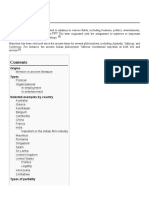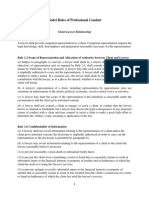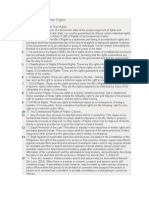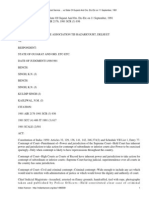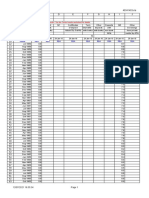Cyber Squatting
Cyber Squatting
Uploaded by
Swathi RamanCopyright:
Available Formats
Cyber Squatting
Cyber Squatting
Uploaded by
Swathi RamanCopyright
Available Formats
Share this document
Did you find this document useful?
Is this content inappropriate?
Copyright:
Available Formats
Cyber Squatting
Cyber Squatting
Uploaded by
Swathi RamanCopyright:
Available Formats
Cybersquatting
Cybersquatting (also known as domain squatting), according to the United States federal law known as the Anticybersquatting Consumer Protection Act, is registering, trafficking in, or using a domain name with bad faith intent to profit from the goodwill of a trademark belonging to someone else. The cybersquatter then offers to sell the domain to the person or company who owns a trademark contained within the name at an inflated price. The term is derived from "squatting", which is the act of occupying an abandoned or unoccupied space or building that the squatter does not own, rent, or otherwise have permission to use. Cybersquatting, however, is a bit different in that the domain names that are being "squatted" are (sometimes but not always) being paid for through the registration process by the cybersquatters. Cybersquatters usually ask for prices far greater than that at which they purchased it. Some cybersquatters put up derogatory remarks about the person or company the domain is meant to represent in an effort to encourage the subject to buy the domain from them.[citation
needed]
Others post paid links via Google, Yahoo!, Ask.com and other paid
advertising networks to the actual site that the user likely wanted, thus monetizing their squatting.
Technical strategies for cybersquatters
Cybersquatters sometimes register variants of popular trademarked names, a practice known as typosquatting. Another strategy is as follows: Internet domain name registrations are for a fixed period of time. If the owner of a domain name doesn't re-register the name with an internet registrar prior to the domain's expiration date, then the domain name can be purchased by anybody else after it expires. [1] At this point the registration is considered lapsed. A cybersquatter may use automated software tools to register the lapsed name the instant it is lapsed. This strategy is also known as renewal snatching, extension exaggeration, and alert angling. [edit]Legal
resolution
Domain name disputes involving alleged bad-faith registration are typically resolved using the Uniform Domain Name Resolution Policy (UDRP) process developed by the Internet Corporation for Assigned Names and Numbers (ICANN). Critics claim that the UDRP process favors large corporations and that their decisions often go beyond the rules and intent of the dispute resolution policy. A UDRP complaint may be initiated at UDRP proceeding with an approved dispute resolution service provider. A victim of cybersquatting may also file an InterNIC Registrar Problem Report regarding a cybersquatter posing as a registrar. Court systems can also be used to sort out claims of cybersquatting, but jurisdiction is often a problem, as different courts have ruled that the proper location for a trial is that of the plaintiff, thedefendant, or the location of the server through which the name is registered. Countries such as China and Russia do not view cybersquatting in the same way or degree that US law does. People often choose the UDRP (Uniform Dispute Resolution Process) created by ICANN because it is usually quicker and cheaper ($2,000 to $3,000 in costs and fees vs. $10,000 or more) than going to court, but courts can and often do overrule UDRP decisions. In Virtual Works, Inc. v. Volkswagen of America,
Inc. (a dispute over the domain vw.net), the Fourth Circuit Court of Appeals created a common law requirement that the cybersquatter must exhibit a bad faith intent in order to confer liability. This means that domain names bearing close resemblance to trademarked names are notper se impermissible. Rather, the domain name must have been registered with the bad faith intent to later sell it to the trademark holder. This "bad faith" concept is reiterated in 15 U.S.C. 1125 and U.S.C. 1129. Some countries have specific laws against cybersquatting beyond the normal rules of trademark law. The United States, for example, has the U.S. Anticybersquatting Consumer Protection Act(ACPA) of 1999. This expansion of the Lanham (Trademark) Act (15 U.S.C.) is intended to provide protection against cybersquatting for individuals as well as owners of distinctive trademarked names. However, even notable personalities, including rock star Bruce Springsteen and actor Kevin Spacey, failed to obtain control of their names on the internet, which indicates the lack of protection afforded to the average businessman or individual.[citation needed] Jurisdiction is an issue, as shown in the case involving actor Kevin Spacey, in which Judge Gary A. Feess, of the United States District Court of the Central District of California, ruled that Spacey would have to file a complaint in a Canadian court, where the current owner of kevinspacey.com resided. Spacey later won the domain through the National Arbitration Forum. Under UDRP policy, successful complainants can have the names deleted or transferred to their ownership (which means paying regular renewal fees on all the names or risk their being registered by someone else). Under the ACPA (Anticybersquatting Consumer Protection Act) a cybersquatter can be held liable for actual damages or statutory damages in the amount of a maximum of $100,000 for each name found to be in violation, although application of this act in the form of actual fines assessed are few in number. In one of the first applications of the ACPA, the plaintiff, Brian Salle, sought relief under 15 U.S.C. 1125 and U.S.C. 1129 from defendant Garner W. Meadows. The court rejected the plaintiff's argument that "all personal names" are protected under the act and established that personal names must be "protected as a mark" for 15 U.S.C. 1125(d) to apply. The court did award summary judgement under 15 U.S.C. 1129(1)(A), with the award being the transfer of the domain briansalle.com to his control and judgment for attorney's fees against Garner W. Meadows of approximately $30,000.00. Monetary awards under the ACPA are infrequent at best, and the cost of filing a case is prohibitive for the average individual. [citation needed] There have been several instances of companies, individuals or governments trying to take generic domain names away from their owners by making false claims of trademark violation. Sometimes they are successful. This practice is called "reverse domain hijacking". For example, little known Heathrow Land Development in Florida attempted to use their narrow one-class trademark and the UDRP process to acquire heathrow.com. Australia is another example auDA requires anyone registering a .com.au second-level domain to have a valid entitlement for that domain i.e. a registered business name with an Australian Business Number (ABN) issued by the Australian Taxation Office. However, this has failed to protect Australia from such cybersquatting acts. Any Australian citizen over the age of 16 can obtain an ABN (which is free) and use it to register as few or as many domain names as they like but they need to have a "close and substantial" connection to the name or it needs to be an "exact match, abbreviation or acronym" of their name. Check auDA for further details. Canada through its own internet regulating body, the Canadian Internet Registration Authority (CIRA) has taken a similar approach to Australia. Registrations for a .ca country code top-level domain must meet "Canadian Presence" requirements. The list is extensive and includes
individual citizens and residents of Canada and in addition, Canadian businesses, Aboriginal Peoples and Indian Bands, Canadian trademark holders (whether Canadian or Foreign), Her Majesty the Queen and, Foreign Businesses with a physical Canadian presence. However, as with Australia, even this has failed to protect Canada from cybersquatting acts.
Social Media
With the rising of social media websites such as Facebook and Twitter, a new form of cybersquatting involves registering trademark-protected brands or names of public figures on popular social media websites. On June 5, 2009, Tony La Russa, the manager of the St. Louis Cardinals, filed a complaint against Twitter, accusing Twitter of cybersquatting [7]. The dispute centered on a Twitter profile that used La Russas name, had a picture of La Russa, and had a headline that said Hey there! Tony La Russa is now using Twitter. The profile encouraged users to join today to start receiving Tony La Russas updates. According to La Russa, the status updates were vulgar and derogatory. La Russa argued that the author of the profile intended, in bad faith, to divert Internet traffic away from La Russas website and make a profit from the injury to La Russas mark [7]. On June 26, 2009, La Russa filed a notice of voluntary dismissal after the parties settled the case [8].
Efforts to curtail cybersquatting in social media
Social networking websites have attempted to curb cybersquatting, making cybersquatting a violation of their terms of service. Twitter Twitters Name Squatting policy forbids the cybersquatting as seen in many domain name disputes, like "username for sale" accounts: Attempts to sell or extort other forms of payment in exchange for usernames will result in account suspension[9]. Additionally, Twitter has an Impersonation Policy that forbids non-parody impersonation. An account may be guilty of impersonation if it confuses or misleads others; "accounts with the clear intent to confuse or mislead may be permanently suspended. Twitters standard for defining parody is whether a reasonable person would be aware that the fake profile is a joke[10]. Lastly, soon after the La Russa suit was filed, Twitter took another step to prevent identity confusion caused by squatting by unveiling Verified Accounts [11]." Usernames stamped with the verified account insignia indicate that the accounts are real and authentic. Facebook Facebook reserves the right to reclaim usernames on the website if they infringe on a trademark [12]. Trademark owners are responsible for reporting any trademark infringement on a username infringement form Facebook provides. Furthermore, Facebook usernames require mobile phone authentication[12]. In order to obtain a username, the individual needs to verify the account by phone.
You might also like
- Bronsteen's Writing A Legal Mem - John BronsteenDocument88 pagesBronsteen's Writing A Legal Mem - John BronsteenCecelia DoreenNo ratings yet
- Mobile Devices: New Challenges For Admissibility of Electronic EvidenceDocument5 pagesMobile Devices: New Challenges For Admissibility of Electronic EvidenceAbsalomNo ratings yet
- Nepotism 1Document17 pagesNepotism 1Konstantinos MantasNo ratings yet
- Gender DiscriminationDocument6 pagesGender DiscriminationAhmedHassanKanju100% (1)
- Waiver Solution in Public Health and Pharmaceutical Domain Under TRIPS AgreementDocument7 pagesWaiver Solution in Public Health and Pharmaceutical Domain Under TRIPS AgreementRojina ThapaNo ratings yet
- LegCoun - 062918 (Paper)Document7 pagesLegCoun - 062918 (Paper)Francis DiazNo ratings yet
- Model Rules of Professional ConductDocument5 pagesModel Rules of Professional ConductNicholas EspenanNo ratings yet
- Legal Costs - Your Right To Know (Form 2)Document4 pagesLegal Costs - Your Right To Know (Form 2)David StoneNo ratings yet
- 2005, The Effects of Imprisonment On Families and Children of PrisonersDocument22 pages2005, The Effects of Imprisonment On Families and Children of PrisonersEduardo RamirezNo ratings yet
- Legal Research ProposalDocument4 pagesLegal Research ProposaltsetenNo ratings yet
- Buck V BellDocument2 pagesBuck V BellJune Steve Barredo100% (1)
- Evidence Class Notes (Seat 114) : Banera v. City of QuincyDocument58 pagesEvidence Class Notes (Seat 114) : Banera v. City of Quincyhplively3284No ratings yet
- Animal LawDocument30 pagesAnimal LawCarla Suárez FélixNo ratings yet
- Reflection HR RA 10175Document3 pagesReflection HR RA 10175rosemarie madarangNo ratings yet
- MSJ Memo of Law-Sexual Harassment RetaliationDocument15 pagesMSJ Memo of Law-Sexual Harassment RetaliationRich BradfordNo ratings yet
- Governor's Office LetterDocument2 pagesGovernor's Office LetterWFTVNo ratings yet
- Professional Negligence Law of Torts Project: Advika PhotumshettyDocument15 pagesProfessional Negligence Law of Torts Project: Advika PhotumshettyadvikaNo ratings yet
- Elements Constituting A CrimeDocument12 pagesElements Constituting A CrimeCP Ispat Unit IINo ratings yet
- Some Remarks On Ethiopia's New Cybercrime LegislationDocument11 pagesSome Remarks On Ethiopia's New Cybercrime LegislationDESSIE FIKIRNo ratings yet
- Criminal Complaint Against Prof. Zhengdong ChengDocument24 pagesCriminal Complaint Against Prof. Zhengdong ChengMaritza Nunez100% (1)
- Child and Women WelfareDocument5 pagesChild and Women WelfareRoopa GuruswamyNo ratings yet
- Moral Character Determination Application InstructionsDocument11 pagesMoral Character Determination Application InstructionsAdam CohenNo ratings yet
- ABA Ethics Opinion 06-441 Excessive CaseloadsDocument9 pagesABA Ethics Opinion 06-441 Excessive Caseloadsthomasmoore99No ratings yet
- Evidence Law SynopsisDocument2 pagesEvidence Law SynopsisGarvit ChaudharyNo ratings yet
- Policies and Schemes of Central and State Governments For People With DisabilitiesDocument128 pagesPolicies and Schemes of Central and State Governments For People With Disabilitiesmanjunatha tNo ratings yet
- Final Essay Int Criminal LawDocument27 pagesFinal Essay Int Criminal LawDevota NuweNo ratings yet
- Ut CourseworkDocument6 pagesUt Courseworkf5dmncxc100% (2)
- Justice Delayed in Criminal CasesDocument11 pagesJustice Delayed in Criminal CasesApurva MathurNo ratings yet
- Legal Analysis: Walker v. Georgetown Housing Authority, 424 Mass. 671 (1997), HeldDocument1 pageLegal Analysis: Walker v. Georgetown Housing Authority, 424 Mass. 671 (1997), HeldMike P Murphy100% (1)
- Muthoot Finance NCD Application Form Mar 2012Document8 pagesMuthoot Finance NCD Application Form Mar 2012Prajna CapitalNo ratings yet
- Business Law Chapter 4Document21 pagesBusiness Law Chapter 4Saly AntonNo ratings yet
- Criminal Law Review Cases For MidtermsDocument3 pagesCriminal Law Review Cases For MidtermsKim ArizalaNo ratings yet
- Timisha Chauhan Research ProposalDocument10 pagesTimisha Chauhan Research ProposalGarvitNo ratings yet
- Law of Torts, Motor Accident Claims and ConsumerDocument133 pagesLaw of Torts, Motor Accident Claims and ConsumerdarveshkapdiNo ratings yet
- California v. Cabazon Band of Mission Indians, 480 U.S. 202 (1987)Document22 pagesCalifornia v. Cabazon Band of Mission Indians, 480 U.S. 202 (1987)Scribd Government DocsNo ratings yet
- A Project On Elements of DefamationDocument29 pagesA Project On Elements of DefamationYashi100% (1)
- Filipino Citizens and Their RightsDocument5 pagesFilipino Citizens and Their RightsMaria Cristela BrazilNo ratings yet
- Rough Draft-Protection of Trade Secrets and Traditional KnowledgeDocument7 pagesRough Draft-Protection of Trade Secrets and Traditional KnowledgeAbhishek PratapNo ratings yet
- Jurisprudence, Concept and Philosophy of LawDocument9 pagesJurisprudence, Concept and Philosophy of LawAnkita GhoshNo ratings yet
- Synthesis Paper Starling 4Document21 pagesSynthesis Paper Starling 4api-336624511No ratings yet
- Serrano-Moran v. Toledo-Davila, 195 F.3d 68, 1st Cir. (1999)Document2 pagesSerrano-Moran v. Toledo-Davila, 195 F.3d 68, 1st Cir. (1999)Scribd Government DocsNo ratings yet
- From Deterrence To Rehabilitation: The Evolving Objectives of Criminal LawDocument16 pagesFrom Deterrence To Rehabilitation: The Evolving Objectives of Criminal LawSHEMNo ratings yet
- Race For Inclusion:: The Experiences of Black, Asian & Minority Ethnic SolicitorsDocument56 pagesRace For Inclusion:: The Experiences of Black, Asian & Minority Ethnic SolicitorsLegal Cheek0% (1)
- Principles of Natural JusticeDocument6 pagesPrinciples of Natural Justicecarljohns_gtaNo ratings yet
- Problem of Brain Drain in IndiaDocument3 pagesProblem of Brain Drain in IndiaHardik PatelNo ratings yet
- California Stem Cell Agency Contract With StemCells, Inc.Document71 pagesCalifornia Stem Cell Agency Contract With StemCells, Inc.California Stem Cell ReportNo ratings yet
- Judicial IndependenceDocument7 pagesJudicial IndependenceML BanzonNo ratings yet
- OSB 2017 FuturesTF SummaryDocument20 pagesOSB 2017 FuturesTF SummaryLaura OrrNo ratings yet
- Power of President To Grant PardonDocument10 pagesPower of President To Grant PardonSubh AshishNo ratings yet
- HR19 - Lower Cost More Cures Two-Pager - FINALDRAFT - v3Document2 pagesHR19 - Lower Cost More Cures Two-Pager - FINALDRAFT - v3Mike SullivanNo ratings yet
- Prepare Report On Human Rights Violation in India and Main Reasons Behind Its ViolationsDocument11 pagesPrepare Report On Human Rights Violation in India and Main Reasons Behind Its ViolationsAvaniJainNo ratings yet
- Regulatory Framework For The Transfer of Technology in Nigeri 1Document21 pagesRegulatory Framework For The Transfer of Technology in Nigeri 1Oketa Daniel100% (2)
- Role of JudgesDocument21 pagesRole of Judgeschidige sai varnithaNo ratings yet
- Sampling in Research MethodologyDocument18 pagesSampling in Research Methodologyselva20No ratings yet
- Effective Approaches to Poverty Reduction: Selected Cases from the Asian Development BankFrom EverandEffective Approaches to Poverty Reduction: Selected Cases from the Asian Development BankNo ratings yet
- Unit 2 Cyber Law and Internet SecurityDocument7 pagesUnit 2 Cyber Law and Internet Security90scartoonshowskidNo ratings yet
- Cybersquatting in IndiaDocument25 pagesCybersquatting in IndiaArpitNo ratings yet
- Cybersquatting IPRDocument6 pagesCybersquatting IPRHarsh VardhanNo ratings yet
- PetroliumDocument15 pagesPetroliumwashlawdailyNo ratings yet
- D N C S: Omain AME EaningDocument5 pagesD N C S: Omain AME EaningAVNISH PRAKASHNo ratings yet
- Nirbaya Act PDFDocument28 pagesNirbaya Act PDFSwathi Raman50% (2)
- Sociological TheoriesDocument14 pagesSociological TheoriesSwathi RamanNo ratings yet
- NOVARTIS vs. Union of India: Some LessonsDocument9 pagesNOVARTIS vs. Union of India: Some LessonsSwathi RamanNo ratings yet
- An Introduction To Indian Environmental LawDocument13 pagesAn Introduction To Indian Environmental LawSwathi RamanNo ratings yet
- Delhi Judicial Service ... Vs State of Gujarat and Ors. Etc-Etc On 11 September, 1991Document40 pagesDelhi Judicial Service ... Vs State of Gujarat and Ors. Etc-Etc On 11 September, 1991Swathi RamanNo ratings yet
- Stridhan & Women's EstateDocument10 pagesStridhan & Women's EstateSwathi RamanNo ratings yet
- Delegation of Power and Its LimitationsDocument5 pagesDelegation of Power and Its LimitationsSwathi RamanNo ratings yet
- D3 Monetary Aggregates D3 Monetary Aggregates: Source RBA RBA RBA RBA RBA RBA RBA RBA RBADocument34 pagesD3 Monetary Aggregates D3 Monetary Aggregates: Source RBA RBA RBA RBA RBA RBA RBA RBA RBAall41_14allNo ratings yet
- Potential Business and Staff Impact AnalysisDocument5 pagesPotential Business and Staff Impact AnalysisMichelle EsternonNo ratings yet
- The Book of AbrahaM and The Islamic Qiṣaṣ Al-Anbiyā (Tales of The Prophets) Extant LiteratureDocument21 pagesThe Book of AbrahaM and The Islamic Qiṣaṣ Al-Anbiyā (Tales of The Prophets) Extant LiteratureMerveNo ratings yet
- Prepared by - Snehal ChintalaDocument78 pagesPrepared by - Snehal ChintalaSnehal ChintalaNo ratings yet
- Assignment 4Document6 pagesAssignment 4Abdullahi WaaberiNo ratings yet
- Sultan Hasanudi1Document2 pagesSultan Hasanudi1bang ooyNo ratings yet
- Irena Remap DHC Report 2017Document112 pagesIrena Remap DHC Report 2017Dewanjee AshrafNo ratings yet
- Course: Sonicwall Network Security Administrator (Snsa) For Sonicos 7Document3 pagesCourse: Sonicwall Network Security Administrator (Snsa) For Sonicos 7JoselitoNo ratings yet
- Tut Sol W1 COIS20024 2011 V1Document8 pagesTut Sol W1 COIS20024 2011 V1Santhu KsskNo ratings yet
- Juvenile Delinquent: The Role of Family Relationship To Self-EsteemDocument5 pagesJuvenile Delinquent: The Role of Family Relationship To Self-EsteemNellajEspinosaNo ratings yet
- Post Activity Report - Area 2Document7 pagesPost Activity Report - Area 2Irene P. MartinezNo ratings yet
- Brand Audit of DHLDocument33 pagesBrand Audit of DHLAyesha Khalid100% (1)
- 108 Names of Lord GaneshaDocument4 pages108 Names of Lord GaneshaananthuvNo ratings yet
- GS Cross Asset CarryDocument16 pagesGS Cross Asset CarryHarry MarkowitzNo ratings yet
- Microsoft Blizzard Merger AgreementDocument131 pagesMicrosoft Blizzard Merger AgreementRoman Octavio PazNo ratings yet
- Itr-7 Guidance NoteDocument75 pagesItr-7 Guidance NoteVijayakumar PonnambalamNo ratings yet
- Progress Test-4Document2 pagesProgress Test-4buraale94No ratings yet
- Karnataka Housing Board, Bangalore-09.: Name of The FirmDocument7 pagesKarnataka Housing Board, Bangalore-09.: Name of The Firmpankaj kadkolNo ratings yet
- Public Meeting Presentation For Sonterra Road ExtensionDocument16 pagesPublic Meeting Presentation For Sonterra Road ExtensionMasonNo ratings yet
- Existential Risk From Artificial General Intelligence: Main ArticleDocument3 pagesExistential Risk From Artificial General Intelligence: Main ArticleVarun MalikNo ratings yet
- Final Exam (Oral) : Name - ClassDocument13 pagesFinal Exam (Oral) : Name - ClassRozaNo ratings yet
- 2015 - 09 - 02 GR 188639Document3 pages2015 - 09 - 02 GR 188639SabNo ratings yet
- Global Automotive Consumer Study 2021 11 14Document4 pagesGlobal Automotive Consumer Study 2021 11 14David Orjeda SincheNo ratings yet
- PROBLEM SOLVING Financial Analysis 2Document1 pagePROBLEM SOLVING Financial Analysis 2Arminda Villamin67% (3)
- Neighborhood Health 2023 Executive SummaryDocument11 pagesNeighborhood Health 2023 Executive SummaryMatthew SelfNo ratings yet
- People v. BocarDocument5 pagesPeople v. BocarRogelio BataclanNo ratings yet
- Southwest Airlines Case StudyDocument9 pagesSouthwest Airlines Case StudydbdfNo ratings yet
- Your Adv Plus Banking Preferred Rewards Platinum: Account SummaryDocument4 pagesYour Adv Plus Banking Preferred Rewards Platinum: Account SummaryCarlos LoyolaNo ratings yet
- GWF079766469 AppointmentLetterDocument2 pagesGWF079766469 AppointmentLettertaqwaair71No ratings yet
- Bookmap Education Part 1Document45 pagesBookmap Education Part 1Dey CHdezNo ratings yet


